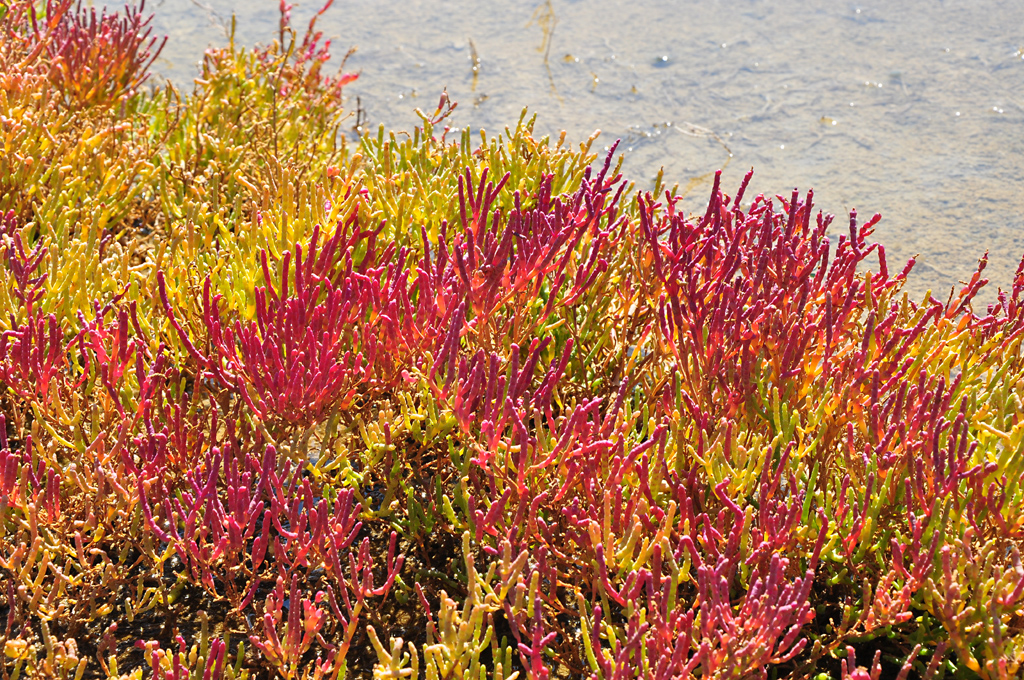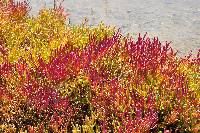Herbs, annual, fleshy, glabrous. Stems prostrate to erect, simple to many-branched, apparently jointed and fleshy when young, becoming not jointed and somewhat woody with age. Leaves opposite, connate basally, sessile, decurrent portions forming fleshy segments enclosing stem, fleshy; blade reduced to fleshy scales, margins entire, narrow, scarious. Inflorescences spikes, terminal on each stem, apparently jointed, each joint (fertile segment) consisting of 2 axillary, opposite, usually 3-flowered cymes embedded in and adherent to fleshy tissue of distal internode; flowers in each cyme arranged in triangle, the 2 lateral flowers meeting beneath central flower, flowers separated by persistent flaps of internodal tissue. Flowers usually bisexual, ± radially symmetric; perianth segments persistent in fruit, usually 3, connate except for extreme tips, fleshy; stamens (0-)1-2; styles 2. Fruits utriclelike; pericarp membranous. Seeds vertical, ellipsoid; seed coat yellowish brown, thin, membranous, hairy; perisperm absent. x = 9.
Salicornia is occasionally utilized as a vegetable in Europe, especially the tetraploid species. The seeds are rich in oils and experimental trials have been undertaken in the southwestern United States to harvest tetraploid species, especially S. bigelovii, on a large scale as a commercial source of vegetable oils.
Because of the succulence of the plants and the highly reduced morphology, it has been difficult to develop a satisfactory taxonomy of the genus. Dried specimens often cannot be determined with certainty, and are of little use in taxonomic studies owing to the loss of characteristics on drying. Salicornia is also difficult to cultivate satisfactorily because the plants appear to require a limited amount of salt and, the tetraploids in particular, occasional submersion in water, although they do not grow well in permanently waterlogged soils.
R. L. Jefferies and L. D. Gottlieb (1982) and S. L. Wolff and R. L. Jefferies (1987, 1987b), using isozyme data, have shown that the diploid taxa are largely homozygous inbreeding lines. There is for the most part good correlation between morphological and isozyme data, but it must be emphasized that the geographical coverage and the number of populations studied are limited.
Fls perfect or pistillate, in groups of 3 and deeply sunken in pits in the axis of a fleshy spike above the axils of scale-like bracts; cal obpyramidal, fleshy, not lobed, opening by a small terminal slit only, becoming spongy at maturity; stamens 1 or 2, the anthers exsert; ovary laterally compressed; styles 2, short; fr enclosed in the cal, the pericarp none; annual or perennial succulent herbs with jointed, usually freely branched stems, the lvs reduced to minute, opposite, scarcely projecting scales; uppermost scales crowded, forming a cylindric terminal spike. All spp. vary greatly in height and branching; all branches normally terminate in a spike, the fls appearing in late summer. The plants often turn bright red in autumn. (Sarcocornia) 25, widespread.
Gleason, Henry A. & Cronquist, Arthur J. 1991. Manual of vascular plants of northeastern United States and adjacent Canada. lxxv + 910 pp.
©The New York Botanical Garden. All rights reserved. Used by permission.





